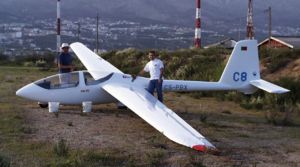PlaneSpottingWorld welcomes all new members! Please gives your ideas at the Terminal.
Politechnika Warszawska PW-6
| Bath time for "Charlie Eight". Covilhã, Portugal. | |
| Type designation | PW-6U |
| Competition class | Two-seater |
| Number built | - |
| Crew | 2 |
| Length | 7.85 m (25.8 ft) |
| Height | 2.44 m (8 ft) |
| Cockpit width | 0.7 m (2.3 ft) |
| Cockpit height | 1.0 m (3.3 ft) |
| Wingspan | 16.00 m (52.5 ft) |
| Wing area | 15.25 m² (164 ft²) |
| Aspect ratio | 16.8 |
| Wing profile | NN 18-17 |
| Empty mass | ca. 360 kg (790 lb) |
| Maximum mass | 546 kg (1200 lb) |
| Wing loading | ca. 31 - 36 kg/m² |
| Maximum speed | 260 km/h (140 knots) |
| Maneuver speed | 163 km/h (88 knots) |
| Stall speed | 68 km/h (37 knots) |
| Minimum sink rate | 0.75 m/s at 90 km/h (147 ft/min at 49 knots) |
| Best glide ratio | 34 at 105 km/h (57 knots) |
The Politechniki Warszawskiej PW-6U is a Polish two-seat training sailplane designed at the Warsaw Polytechnic for basic flight instruction and transition training to the PW-5 single-seater. It is manufactured at PZL Świdnik since 2000.
Contents
History
The PW-6 was designed to be an ab initio trainer with the capability of providing cross-country training as well. It has handling and performance characteristics similar to the Politechniki Warszawskiej PW-5. In this way, the transition to solo flying in the single-seater can be made sooner.
The prototype of the PW-6, built at DWLKK, made its maiden flight from Bemowo Airfield, Warsaw, in July 1998. Type certification was granted in September 2000, with Jerzy Kedzierski and Maciej Lasek having performed the test flights. Serial production started at PZL Swidnik soon afterwards, with first deliveries to Egypt, New Zealand, Belgium, Canada, United States, Portugal and Germany.
Technical Description
- Classical shoulder-wing, two seater, tandem layout, designed in accordance with the requirements of JAR-22 Utility Category.
- Wing shape and profile are similar to the PW-5 design: trapeze contour with bow-shaped ends, shoulder-set on the fuselage, having a monospar structure with sandwich shells. Schempp-Hirth-type air brakes extend on the upper wing surface only.
- Fuselage shell of glass-epoxy composite monocoque structure, stiffened with frames. Fabric covered rudder.
- Fixed undercarriage consisting of main wheel behind the rear pilot, with shock absorber and drum brake, a smaller front wheel and a robust tail wheel to prevent ground scraping if over rotation takes place during take off or landing.
- Two tow releases, for aerotowing and winch-launching respectively.
Flying, safety and operational qualities
- The ground handling and flying qualities of the PW-6 are nearly identical to those of the PW-5 in spite of its larger size: light control stick, stiffish rudder, partially balanced elevator and a four and a half second roll rate. The objective of similar handling between the single-seater and the two-seater was realised.
- Cockpit ergonomics are adequate in spite of several details being behind the times, such as the awkward seat belts fitted at the factory that are tightened by pushing down rather than pulling upwards on the straps, a stiff trim control with discrete steps, and the inefficient ventilation side scoop. It lacks automatic control hook-ups at the wings, which is somewhat compensated by having easy and safe polish-type connectors. The elevator is connected by a nut and bolt that can easily be misplaced upon derriging.
- The cockpit is crashworthy, as demonstrated by an accident in which the glider was destroyed in a collision with a fence without harm to the occupants.
- As a trainer, the PW-6 is an affordable option bridging the gap between the older generation wood and fabric trainers and the highly sophisticated and comparatively expensive performers such as the DG-1000. While the PW-6 does not equal the latter's high speed polar, it fulfills ab-initio through cross-country training roles. Significantly, it can spin and be used for basic aerobatic and cloud flying training.
- The PW-6 is a competent machine for introductory cross-country training, as its extra weight, compared to its smaller stablemate, gives it somewhat better penetration at cross-country speeds. Its easy rigging and de-rigging are its main attractions in this role. It also climbs well and is easy to control in landouts, although its relatively high landing speed detracts somewhat from this.
Designation sequence
PW-ULS - PW-2 Gapa - PW-3 Bakcyl - PW-4 Pelikan - PW-5 Smyk - PW-5M - PW-6
Projected derivatives
- PW-7 Motorglider project: two seater side-by-side motorglider, with PW-6 wing geometry.
- PW-9A Aerobatic Training Glider, automatic control connections and tail ballast compartment.
- PW-9M Self Launching Training Glider, with Solo engine and folding propeller.
Sources
- Ewald J, Flight Test: PW-6, Sailplane and Gliding, Feb-Mar 2001
- The World Class Soaring Association

